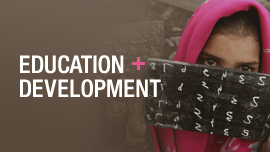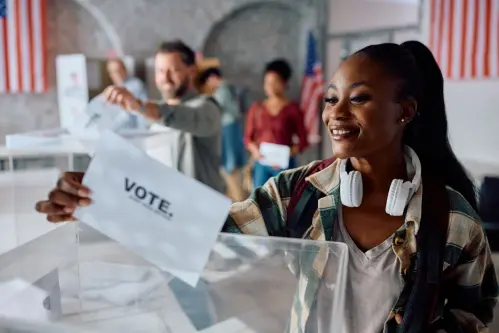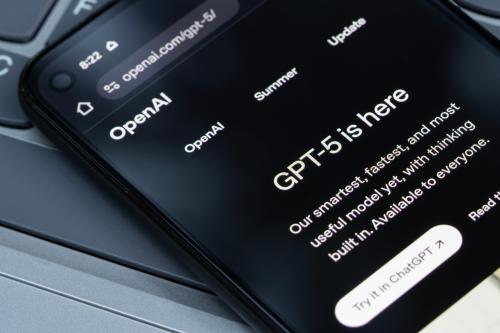Building a pipeline of civically minded leaders and innovators is critical as the world increasingly confronts climate, health, economic, and political crises. Youth in the United States and worldwide are more likely than their older counterparts to exhibit entrepreneurial potential, to be engaged in creative and innovative activities, and to be civically engaged if given the opportunity.
Young people also tend to be more optimistic about the future. One 2024 poll in the U.S. showed that 62% of young people 18 to 29 were optimistic about the world ahead as compared to 49% of people over 60. A global poll in 2021 found 57% of younger people between 15 and 24 believed that the world was becoming a better place compared to only 39% of adults over 40.
Although the under 30 demographic is still a few years away from taking on official national and state leadership positions, their leadership is in the making. In the current U.S. House there is already one Gen Z representative; he is 63 years younger than the oldest representative. Forty-three percent of representatives are over 60. In the U.S. Senate, 66% of senators are over 60 years of age. This generational divide prevails on the international stage, with the average U.N. staff member being 45.9 years old, despite launching multiple initiatives in recent years like the Youth2030 strategy and a global standard of youth engagement and decisionmaking.
One of the most important pipelines for building local, national, and global youth leadership is higher education—including universities and community colleges. According to students at the University of Nevada, Las Vegas, one of the reasons young people go into higher education is to learn “civic engagement and government, cultural competency, leadership, and social skills.” Research indicates that young people who completed college or university are more likely to be encouraged to take on leadership roles than those who completed only high school. Prioritizing civic education opportunities, both in K-12 and throughout higher education, builds critical 21st century skills that position youth to thrive in leadership roles and ensure communities and countries have civically minded leaders. When youth have more leadership opportunities in universities and other institutions, and when they are positioned as experts in their own right with decisionmaking responsibilities, they usually step up to the leadership plate.
Youth as leaders and decisionmakers
Higher education institutions across the U.S. offer opportunities for students to be engaged in important policy decisions, from leading student councils to serving on advisory groups, committees, and boards. These groups serve to coordinate better youth engagement with leadership, increase transparency of decisions, and provide platforms for young people to communicate perspectives on issues impacting their communities.
Yet not every leadership opportunity is transformative for the student or the institution. Students may be missing from decisionmaking bodies or play a token role without official responsibilities or votes. However, some universities have intentionally made sure that students are equal members of boards. For example, the University of California Board of Regents appoints one student delegate as a full voting member. The University of Arizona’s Board of Regents, provides voting rights to two student delegates in the second year of their two-year term. Other institutions, including the University of Minnesota and Texas State University, offer nonvoting membership to students on their boards of regents.
Increasingly, national and global bodies are creating youth advisory groups to create a pipeline for leaders and to ensure youth have a space to voice their perspectives. For example, the Youth Delegate Program ensures that young people are a part of the U.N.’s decisionmaking. Countries appoint youth delegates who provide input into their country’s policy priorities, attend negotiations with world leaders, and participate in cross-national dialogues.
Despite notable institutional efforts to increase youth leadership in civic engagement and decisionmaking in the U.S. and globally, institutions can do more to create an environment where young people use their optimism, innovation, and civic mindset in support of stronger and more relevant leadership and policies. Below are four recommendations inspired by firsthand experiences of young people serving in these roles.
1. Let youth select their own representation
Students should have a leading role in choosing the young people who represent them, as opposed to student representatives being appointed by adult leaders. In the case of the University of Texas at Austin, members of the student government are elected by other students and are granted seats to the President’s Student Advisory Committee, which advises on budget, student life, and academic affairs. Handing over delegatory power to youth ensures they have a role in selecting a young person that represents the student body and can speak directly to their needs.
2. Redesign decisionmaking to meaningfully engage youth
Decisionmaking bodies often include a seat for youth at the table, but the table is often not designed for meaningful engagement. As one youth delegate to the U.N. and other governing spaces noted, “Solo delegates sitting in proximity to powerful officials gives the illusion of youth representation.” Ireland is a great example of a country that is ensuring youth are critical to decisionmaking. The Young Ireland policy framework ensures the “rights of all children and young people are fully recognized and respected.” The Government of Ireland also established the National Youth Parliament, among other youth advisories, where young people from across the country who are between 12 and 18 years old are elected to the Parliament and vote on issues sent to government leaders. The Foundation for Education Development’s Learners’ Council in England provides similar intentional opportunities for young leaders to directly influence policy on children and youth. In these examples, youth are given meaningful and clear roles alongside voting rights to ensure their perspectives are valued in decisionmaking.
3. Remunerate youth leaders and delegates for their time and expertise
Young people’s experiences and perspectives are sought by numerous decisionmaking committees, councils, and advisories. Treating students like the experts they are expected to be is an important step in authentic engagement. Compensation for delegates’ time and expertise makes sure they can show up, regardless of economic circumstances, and are valued for their time and contributions. For example, the City of Long Beach in California has a Youth Advisory Council that compensates its members up to $1,100 a year for their engagement in the design, implementation, and oversight of the Youth Strategic Plan as well as the city’s Youth Power Participatory Budget, which determines spending on youth-centered projects.
4. Support youth innovation and give young people the credit they deserve
Youth ideas have helped fuel innovation in universities as well as civil society and the private sector. Yet, young people are not always given the credit and attribution they deserve. For example, Spotify’s “Spotify Wrapped” was reportedly created by a 2019 intern Jewel Ham, who felt her contributions never received proper credit by a company whose net revenue was 15.6 billion euros in 2024. Many higher education institutions have started innovation challenges to give youth financial resources and mentorship to develop their creative ideas and leadership. For example, the Harvard Innovation Labs give students opportunities to design projects, like developing groundbreaking medical therapies, that tackle major world problems. Innovation challenges at other universities solve problems ranging from food waste to language access for English-language learners and students with speech disabilities. Pairing mentorship with funding catalyzes not only innovation, but a culture of intergenerational collaboration.
Building a pipeline for youth leadership and innovation
Youth are about to inherit a future that they did not make. This future has a myriad of global challenges and crises in store—from climate to human conflict to massive migration. Young people need a reliable and intentional pipeline for developing and stepping into leadership. Delegating a seat to youth is not enough for reinforcing youth leadership—institutions need to think consciously about the design of their councils and boards to ensure youth are not just filling a seat but taking up the places they deserve.
Ida Hansson, the chairperson of the Swedish Association of Hard of Hearing Young People said at the Global Disability Summit on April 3, 2025 to a room full of youth disability advocates and government representatives, “I call on governments to realize youth’s knowledge, experience, and drive… .You’re not just building our future, you are building our present.” As Anne Herman, a government leader from the Cook Islands then replied to youth leaders at the Summit, “young people take your place, leaders make the space for youth”—a critical message for this moment.
The Brookings Institution is committed to quality, independence, and impact.
We are supported by a diverse array of funders. In line with our values and policies, each Brookings publication represents the sole views of its author(s).







Commentary
Building a pipeline for youth leadership and innovation
April 23, 2025